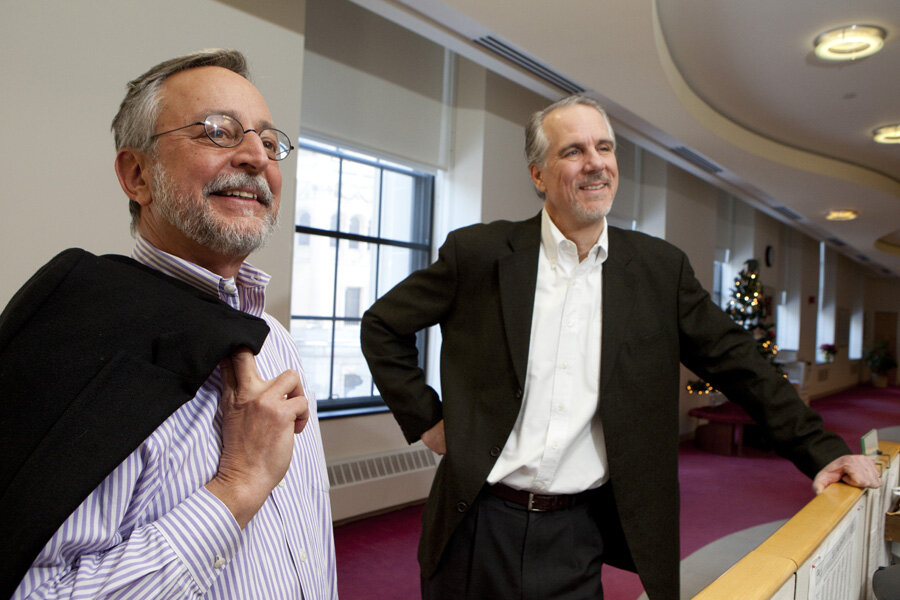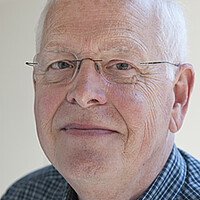New editor named to lead The Christian Science Monitor
Marshall Ingwerson, managing editor of The Christian Science Monitor, was named the newspaper’s editor on Monday, succeeding John Yemma, who led the paper in a much-watched move away from daily print and into Web-first journalism.
The change, scheduled to take effect in late January, was announced at a newsroom meeting Monday by Lyle Young, chairman of The Christian Science Board of Directors. The board acts as publisher of the Monitor.
Mr. Yemma asked to step down to concentrate on writing for the Monitor and to pursue other creative activities. He has been editor since 2008.
Mr. Ingwerson has held numerous positions at the Monitor since joining it in 1979, including as a correspondent in Moscow, Miami, Los Angeles, and Washington, D.C. He has been managing editor since 1999.
“Marshall Ingwerson brings a proven record of integrity, clarity, balance, humility, and insight over years of service to the Monitor. He is committed to its mission of spreading truth to the corners of the earth,” Mr. Young said.
The newly appointed editor said, “I love this place and the work we're about here, so I will do everything I can to help guide us successfully around the next bend in the Monitor's great history.”
Both Young and Ingwerson paid tribute to Yemma’s term as editor.
"We are tremendously grateful to John for leading the Monitor into the new world of Web-first journalism with unwavering faith that people will value honest, excellent news reporting that highlights human progress and demands and expects more,” Young said. “We look forward to John's continued contributions to the Monitor.”
Ingwerson called his predecessor “a transformative leader who made history at the Monitor. He walked us across the bridge to the Web-first world. He has also been an unfailingly delightful guy to work for.”
During Yemma's editorship, the Monitor became one of the first national newspapers in the United States to shift from daily print to a Web-first format. The Monitor now publishes on its continuously updated website, CSMonitor.com; in its newsmagazine, The Monitor Weekly; and via a subscription news summary, The Daily News Briefing (DNB).
CSMonitor.com has more than 12 million unique visitors a month; 50,000 people subscribe to the Monitor Weekly, and 10,000 receive the Monitor DNB. The Monitor also produces specialized publications such as Frontier Markets Monitor and World Business Monitor that provide deeper information from the newspaper's global network of correspondents.
Adapting to major changes in news consumption habits poses continuing substantial challenges to all news organizations. Still, the Monitor has steadily decreased its subsidy from the Christian Science church over the past five years. Last year, it posted its best financial performance since 1961 on an inflation-adjusted basis.
“Together with our partners on the publishing side, we've applied intelligence, energy, and creativity to a strategic shift that has preserved the values of Monitor journalism, expanded the Monitor's reach, and strengthened it financially,” Yemma said. “The humane, internationally-minded journalism envisioned by Mary Baker Eddy when she founded the Monitor in 1908 is on firm footing. Under Marshall’s able editorship, the Monitor will go on to ever greater achievements.”
Yemma was appointed to head the Monitor newsroom after 20 years at The Boston Globe. During an earlier tour with the Monitor in the 1980s, he was stationed in Washington and the Middle East and was the Business Editor. He also worked for The Dallas Morning News, United Press International, and The San Antonio Express-News. A 1974 graduate of the University of Texas at Austin, he was a Reuter Fellow at Oxford University in 1994 and a Sulzberger Fellow at Columbia University in 2008. The Sulzberger program provides intensive training in strategy and innovation to senior news executives.
Ingwerson was a Sulzberger Fellow in 2010. His articles on the oil boom in the Caspian Sea earned an Overseas Press Club citation for 1997. He served as the Monitor’s White House correspondent during the George H.W. Bush and Bill Clinton administrations. Known for his unflappable management style, Ingwerson was managing editor through the terrorism attacks of Sept. 11, 2001, several major newspaper redesigns, and the kidnapping of Monitor freelancer Jill Carroll in 2006. He is married to Clara Germani, who is also a journalist. They live with their teenaged daughter in a house that Ingwerson, a skilled carpenter, is renovating in his spare time.






